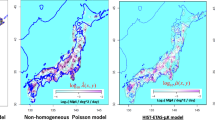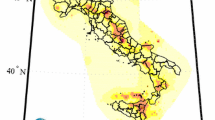Abstract
In this paper, the extent to which some improvement can be made in seismicity-based earthquake forecasting methods are examined. Two methods that employ the statistics and locations for past smaller earthquakes to determine the location of future large earthquakes, the pattern informatics (PI) index and the Benioff relative intensity (RI), are employed for both global and regional forecasting. Two approaches for forecast parameter estimation, the TM metric and threshold optimization, are applied to these methods and the results evaluated. Application of the TM metric allows for estimation of both the training and forecast time intervals as well as the minimum magnitude cutoff and spatial discretization. The threshold optimization scheme is employed in order to formulate a binary forecast that maximizes the Pierce’s skill score. The combined application of these techniques is successful in forecasting those large events that occurred in Haiti, Chile, and California in 2010, on both global and regional scales.














Similar content being viewed by others
References
Cavallo, E., Powell, A., Becerra, O., 2010. Estimating the direct economic damage of the earthquake in Haiti. Inter-American Development Bank working paper series, No. IDB-WP-163.
Chen, C., Rundle, J.B., Holliday, J.R., Nanjo, K.Z., Turcotte, D.L., Li, S., Tiampo, K.F., 2005. The 1999 Chi–Chi, Taiwan, earthquake as a typical example of seismic activation and quiescence. Geophysical Research Letters 32, L22315, doi:10.1029/2005GL023991.
Cho, N.F., Tiampo, K.F., McKinnon, S., Vallejos, J., Klein, W., Dominguez, R., 2010. A simple metric to quantify seismicity clustering, Nonlinear Processes in Geophysics, doi:10.5194/npg-17-293-2010, 17, 293–302, 2010.
Dieterich, J., 1994. A constitutive law for rate of earthquake production and its application to earthquake clustering. J. Geophys. Res. 99, 2601–2618.
Dieterich, J.H., Cayol, V., Okubo, P., 2002. The use of earthquake rate changes as a stress meter at Kilauea volcano. Nature 408, 457–460.
Field, E.H., 2007. Overview of the Working Group for the Development of Regional Earthquake Likelihood Models (RELM), Seis. Res. Letts. 78, 7–16.
Frankel, A.D., Petersen, M.D., Mueller, C.S., Haller, K.M., Wheeler, R.L., Leyendecker, E.V., Wesson, R.L., Harmsen, S.C., Cramer, C.H., Perkins, D.M., Rukstales, K.S., 2002. Documentation for the 2002 update of the national seismic hazard maps. U.S. Geol. Surv. Open-File Rept. OFR-02-420, 33 pp.
Geller, R.J., Jackson, D.D., Kagan, Y.Y., Mulargia, F., 1997. Enhanced: earthquakes cannot be predicted. Science 275, 49–70.
Gerstenberger, M.C., Rhoades, D.A., 2010. New Zealand Earthquake Forecast Testing Centre. Pure Appl. Geophys. 167, 877–892.
Harte, D., Vere-Jones, D., 2005. The entropy score and its uses in earthquake forecasting, Pure Appl. Geophys. 162, 1229–1253.
Holliday, J.R., Nanjo, K.Z., Tiampo, K.F., Rundle, J.B., Turcotte, D.L., 2005. Earthquake forecasting and its verification, Nonlinear Proc. Geophys. 12. doi:1607-7946/npg/2005-12-965.
Holliday, J.R., Rundle, J.B., Tiampo, K.F., Turcotte, D., 2006a. Using earthquake intensities to forecast earthquake occurrence times. NPG 13, 585–593.
Holliday, J.R., Rundle, J.B., Tiampo, Turcotte, D., Klein, W., Tiampo, K.F., Donnellan, A., 2006b. Space-time clustering and correlations of major earthquakes. PRL 97, 238501.
Holmes, P., Lumley, J.L., Berkooz, G., 1996. Turbulence, Coherent Structures, Dynamical Systems and Symmetry, Cambridge, University Press, U.K.
Jiang, C., Wu, Z., 2010a. PI Forecast for the Sichuan-Yunnan Region: Retrospective test after the May 12, 2008, Wenchuan Earthquake. Pure Appl. Geophys. 167, doi:10.1007/s00024-010-0070-8.
Jiang, C., Wu, Z., 2010b. Seismic moment release before the May 12, 2008, Wenchuan earthquake in Sichuan of southwest China, Conc. Comp. 22, 1784–1795.
Jolliffe, I. T., Stephenson, D. B., Forecast Verification: A Practitioner’s Guide in Atmospheric Science (John Wiley, Hoboken, N. J. 2003).
Jordan, T.H., 2006. Earthquake predictability, brick by brick, Seis. Res. Letts. 77, 3–6.
Kanamori, H., 1981. The nature of seismicity patterns before large earthquakes. Earthquake Prediction: An International Review, AGU Monograph. AGU, Washington, D.C., pp. 1–19.
Kovacs, P., 2010. Reducing the risk of earthquake damage in Canada: Lessons from Haiti and Chile. ICLR Research Paper Series, 49.
Lorito, S., Romano, F., Atzori, S., Tong, X., Avallone, A., McCloskey, J., Cocco, M., Boschi, E., Piatanese, A., 2011. Limited overlap between the seismic gap and coseismic slip of the great 2010 Chile earthquake. Nature Geoscience, doi:10.1038/NGEO1073.
Main, I. (moderator), 1999. Is the reliable prediction of individual earthquakes a realistic scientific goal?, Debate in Nature, www.nature.com/nature/debates/earthquake/equake_frameset.html.
Mason, I.B. Binary events. In Forecast Verification (eds. Jolliffe, I.T. and Stephenson, D.B.) (Wiley, Chichester 2003), pp. 37–76.
Molchan, G., Keilis-Borok, V., 2008. Earthquake prediction: Probabilistic aspect. Geophys. J. Int. 173, 1012–1017.
Molchan, G.M., 1991. Structure of optimal strategies in earthquake prediction. Tectonophysics 193, 267–276.
Molchan, G.M., Kagan, Y.Y., 1992. Earthquake prediction and its optimization. J. Geophys. Res. 97, 4823–4838.
Mori H., Kuramoto, Y., 1998. Dissipative Structures and Chaos, Springer-Verlag, Berlin.
Nanjo, K.Z., 2010. Earthquake forecast models for Italy based on the RI algorithm. Ann. Geophys. 53, 3, doi:10.4401/ag-4810.
Nanjo, K.Z., Holliday, J.R., Chen, C.-C., Rundle, J.B., Turcotte, D.L., 2006a. Application of a modified pattern informatics method to forecasting the locations of future large earthquakes in the central Japan. Tectonophysics 424, 351–366, doi:10.1016/j.tecto.2006.03.043.
Nanjo, K.Z., Rundle, J.B., Holliday, J.R., Turcotte, D.L., 2006b. Pattern informatics and its application for optimal forecasting of large earthquakes in Japan. Pure Appl. Geophys. 163, doi:10.1007/s00024-006-0130-2.
Richter, C. F., 1958. Elementary Seismology, Freeman, San Francisco.
Rundle, J.B., Klein, W., Tiampo, K.F., Gross, S., 2000. Linear pattern dynamics of nonlinear threshold systems. Phys. Rev. E 61, 2418–2432.
Rundle, J.B., Tiampo, K.F., Klein, W., Sá Martins, J., 2002. Self-organization in leaky threshold systems: The influence of near mean field dynamics & its implications for earthquakes, neurobiology and forecasting. PNAS, Suppl. 1, 99, 2463.
Shcherbakov, R., Turcotte, D.L., Rundle, J.B., Tiampo, K.F., Holliday, R., 2010. Forecasting the locations of future large earthquakes: An analysis and verification. Pure Appl. Geophys. 167, 743–749, doi:10.1007/s00024-010-0069-1.
Thirumalai, D., Mountain, R.D., Kirkpatrick, T.R., 1989. Ergodic behavior in supercooled liquids and in glasses. Phys. Rev. A 39, 3563–3574.
Thirumalai, D., Mountain, R.D., 1993. Activated dynamics, loss of ergodicity, and transport in supercooled liquids, Phys. Rev. E 47, 479–489.
Tiampo, K.F., Klein, W., Li, H.-C., Mignan, A., Toya, Y., Rundle, J.B., Chen, C.-C., 2010. Ergodicity and earthquake catalogs: Forecast testing and resulting implications. Pure Appl. Geophys. 167, doi:10.1007/s00024-010-0076-2.
Tiampo, K.F., Rundle, J.B., Klein, W. 2006a. Premonitory seismicity changes prior to the Parkfield and Coalinga earthquakes in southern California. Tectonophys. 413, 77–86.
Tiampo, K.F., Rundle, Klein, W., 2006b. Stress shadows determined from a phase dynamical measure of historic seismicity. Pure Appl. Geophys. doi:10.1007/200024-006-0134-y.
Tiampo, K.F., Rundle, J.B., Klein, W., Sá Martins, J.S., Ferguson, C.D., 2003. Ergodic dynamics in a natural threshold system. Phys. Rev. Lett. 91, 238501.
Tiampo, K.F., Rundle, J.B., Klein, W., Sá Martins, J.S., Ferguson, C.D., Holliday, J., 2007. Ergodicity in natural earthquake fault networks. Phys. Rev. E. 75, doi:10.1103/PhysRevE.75.066107.
Tiampo, K.F., Rundle, J.B., McGinnis, S., Gross, S., Klein, W., 2002. Mean-field threshold systems and phase dynamics: An application to earthquake fault systems. Eur. Phys. Lett. 60, 481–487.
Toda, S., Stein, R.S., Sagiya, T., 2002. Evidence from the AD 2000 Izu islands earthquake swarm that stressing rate governs seismicity. Nature 419, 58–61.
Toya, Y., Tiampo, K.F., Rundle, J.B., Chen, C., Li, H., Klein, W., 2009. Pattern Informatics approach to earthquake forecasting in 3D. Conc. Comp., doi:10.1002/cpe.1531.
Turcotte, D.L., 1997. Fractals and Chaos in Geology and Geophysics, Cambridge University Press, Cambridge.
Wu, Y.-H., Chen, C.-C., Rundle, J.B., 2008a. Detecting precursory earthquake migration patterns using the pattern informatics method. Geophys. Res. Ltrs. 35, doi:10.1029/2008gl035215.
Wu, Y.-H., Chen, C.-C., Rundle, J.B., 2008b. Precursory seismic activation of the Pingtung Taiwan offshore doublet earthquakes on 26 December 2006: A Pattern Informatics analysis. Terr. Atm. Oceanic Sc. 19, 743-749, doi:10.3319/tao.2008.19.6.743pt.
Wyss, M., 1997. Cannot earthquakes be predicted? Science, 278, 487–490.
Zechar, J.D., Jordan, T.H., 2008. Testing alarm-based earthquake predictions. Geophys. J. Int. 172, 715–724, doi:10.1111/j.1365-246X.2007.03676.x.
Zechar, J.D., Schorlemmer, D., Liukis, M., Yu, J., Euchner, F., Maechling, P., Jordan, J., 2010. The Collaboratory for the Study of Earthquake Predictability perspective on computational earthquake science. Conc. Comp. 22, 1836–1847.
Zhang, X.T., Zhang, Y.X., Yin, X.C., 2009. Study on the earthquake potential regions in north and northeast China by Pattern Informatics method. Proceeding of the 2009 2nd International Conference on Biomedical Engineering and Informatics, v. 1–4, 2266–2270.
Acknowledgments
The work of K. F. Tiampo was supported by the NSERC and Aon Benfield/ICLR Industrial Research Chair in Earthquake Hazard Assessment. The work of R. Shcherbakov was supported by an NSERC Discovery Grant 355632-2008. Several images were plotted with the help of GMT software developed and supported by Paul Wessel and Walter H.F. Smith.
Author information
Authors and Affiliations
Corresponding author
Rights and permissions
About this article
Cite this article
Tiampo, K.F., Shcherbakov, R. Optimization of Seismicity-Based Forecasts. Pure Appl. Geophys. 170, 139–154 (2013). https://doi.org/10.1007/s00024-012-0457-9
Received:
Revised:
Accepted:
Published:
Issue Date:
DOI: https://doi.org/10.1007/s00024-012-0457-9




